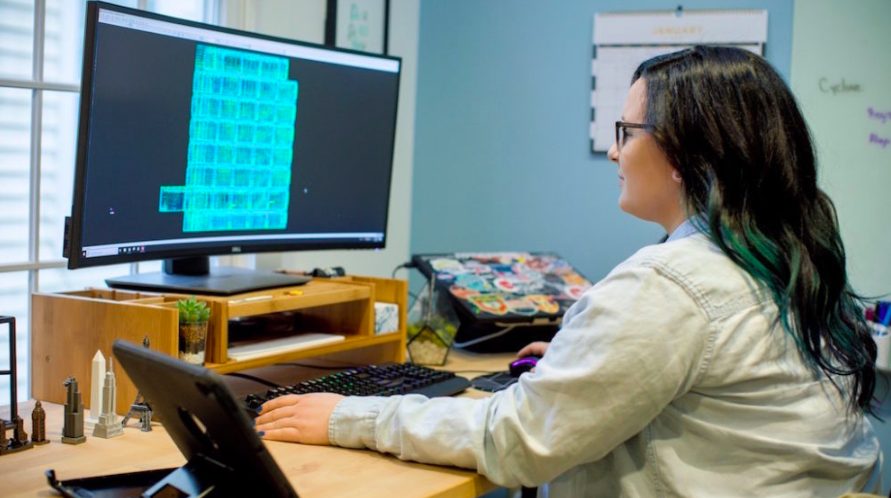After WeWork acquired the Lord & Taylor building in Midtown Manhattan in 2017, one of the first things we needed was a detailed plan of each floor. There were blueprints, of course, but countless changes since the iconic structure was built in 1914 made them inaccurate. Walls had been demolished, windows had been bricked over, and support columns were either in the wrong place or had never existed.
So we called in our reality-capture experts. The 20-member team uses a wide range of equipment—including state-of-the-art laser scanners—to produce remarkably detailed plans of raw spaces that WeWork’s designers transform into beautiful workspaces. The team is used to challenges, but Lord & Taylor was by far the biggest it’s encountered. The average WeWork location takes 20 to 30 scans to create a detailed rendering, according to Thad Wester, director of reality capture. By contrast, the 676,000-square-foot retail space took more than 4,000 scans.
Getting access to many parts of the building—such as the elevator shafts—required ingenuity.
“We wanted to know every single crevice in the building,” says Wester. “So with our $100,000 laser scanner, we rode on top of the elevators so we could scan the inside of the shafts.”
In 2018, Wester’s team worked on 650 projects, delivering 800 billion individual measurements. That makes WeWork one of the world’s largest users of laser-scan-point technology.
“Our team just bought its 13th laser scanner,” says Wester. “And what’s most amazing is that we use all of them basically every day.”
The precision of laser scanning speeds up the process of opening new WeWork locations because it eliminates human error, like faulty measurements or missing doorways.
“For reality capture, the big difference is that WeWork has committed to laser scanning every project,” says Wester. “It’s not a niche offering, but just part of our process.”



Measuring down to the millimeter
Wearing a sweatshirt and knit cap to ward off the chill of an empty building in Manhattan’s Meatpacking District, Austin Jennee is taking shots with a laser scanner mounted atop a 4-foot-tall tripod. These scans are so detailed that you can spot wires dangling from the ceiling or a penny dropped on the floor.
Like many people in this field, Jennee started working in reality capture fairly recently. While employed at a construction company in 2017, he noticed a team using a laser scanner.
“I knew that was something I wanted to do,” says Jennee, the only member of WeWork’s reality-capture team based in New York. “Within three weeks, I was a reality-capture specialist.”
Since joining WeWork in May, he’s scanned dozens of buildings. Recent projects took him to Nashville, Kansas City, and Chicago, where he tackled a 300,000-square-foot bank. Capturing the intricate details of the historic structure took him three days.
The man who built WeWork’s reality-capture team from the ground up was Wester, who earned a master’s degree in geography from East Carolina University in Greenville, North Carolina. “We had a bunch of laser scanners there,” says Wester, “and I fell in love the first time I saw them.”
After college he started his own laser-scanning company, working on high-profile projects like Forest Hills Stadium (the original home of tennis’ U.S. Open) in Queens and the Monte Carlo Hotel and Casino in Las Vegas. He also consulted for the building-technology company Case, later acquired by WeWork.
When WeWork asked Wester to join the team in 2015, it didn’t take him long to say yes.
“I had really liked owning my own business,” says Wester. “But at WeWork I was given the freedom to set my own goals and build out my team the way I needed to. You don’t find that everywhere.”
Wester and four others are based in Florence, South Carolina. That city of fewer than 40,000 people is a surprisingly good location for a reality-capture team: Four members of his team are graduates from nearby Florence-Darlington Technical College.
“I always thought I’d be an architect,” says Ivy Wilson, one of those graduates. “So instead of designing buildings, I get to make models of what they look like.”
Wilson, who stitches together scans taken by other members of the team, had barely heard of laser-scanning technology when Wester reached out to her. “It seemed so innovative, something not everyone was doing,” she says. “It’s an amazing thing to be a part of.”
Wester’s team now includes members in Brazil, China, Mexico, Singapore, and the UK. One of his most recent hires is Shrinivas G, based in Singapore. Before joining WeWork six months ago, he spent nine years doing laser scanning at shipbuilding companies.
“It’s exactly the same technology,” he says, “but at that company, we ended up with drawings of ships.”
Today his projects include a nine-story building in Seoul and a space above a shopping mall in Bangkok. Besides Korea and Thailand, he’s recently traveled to the Philippines, Indonesia, Malaysia, and Vietnam.
“There’s definitely a learning curve here,” he says. “You learn to quickly finish one job so you can move on to the next. There’s always something new on the horizon. That’s what makes this job so exciting.”
WeWork offers companies of all sizes space solutions that help solve their biggest business challenges.







